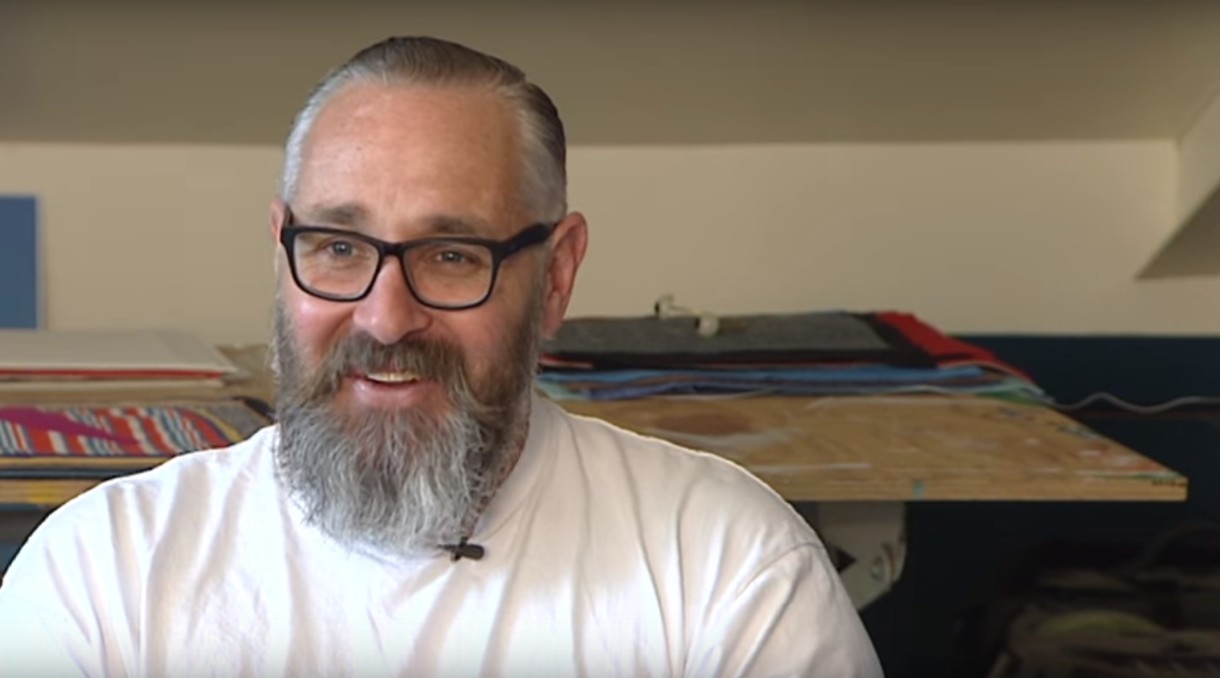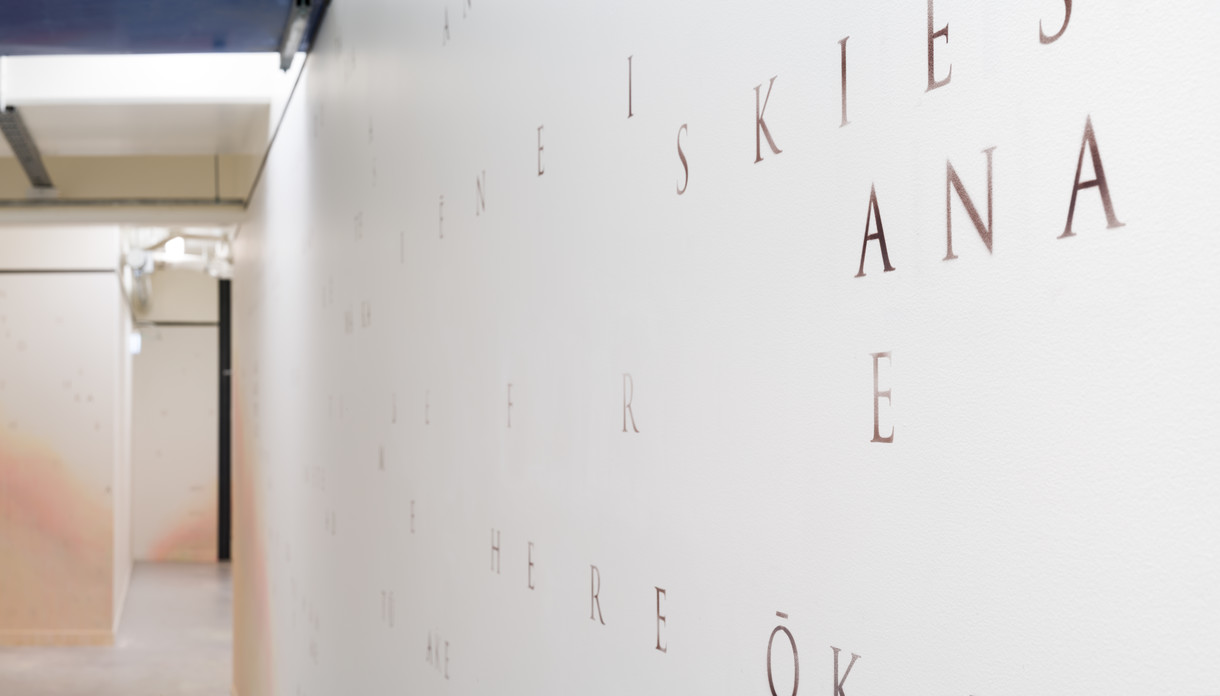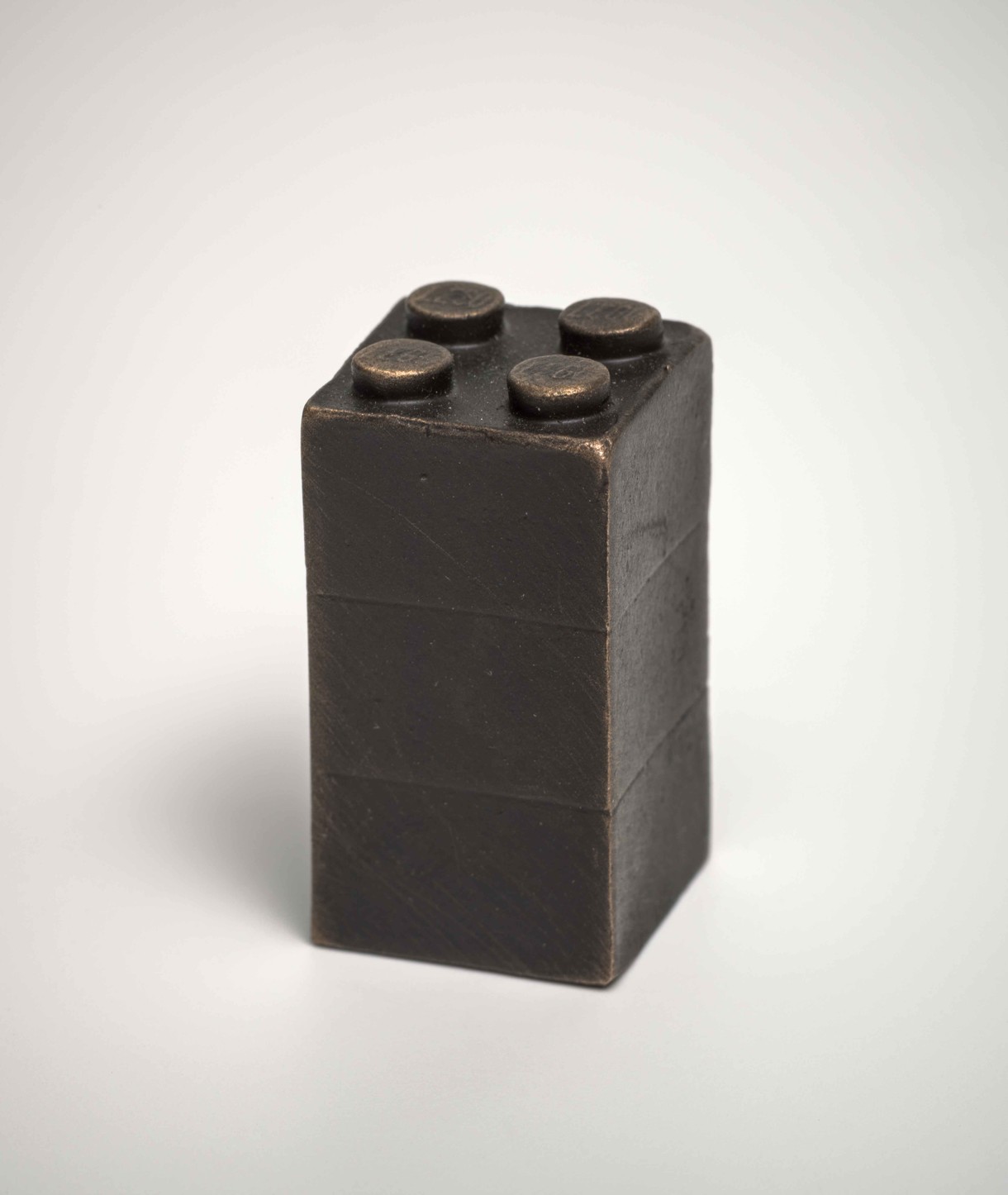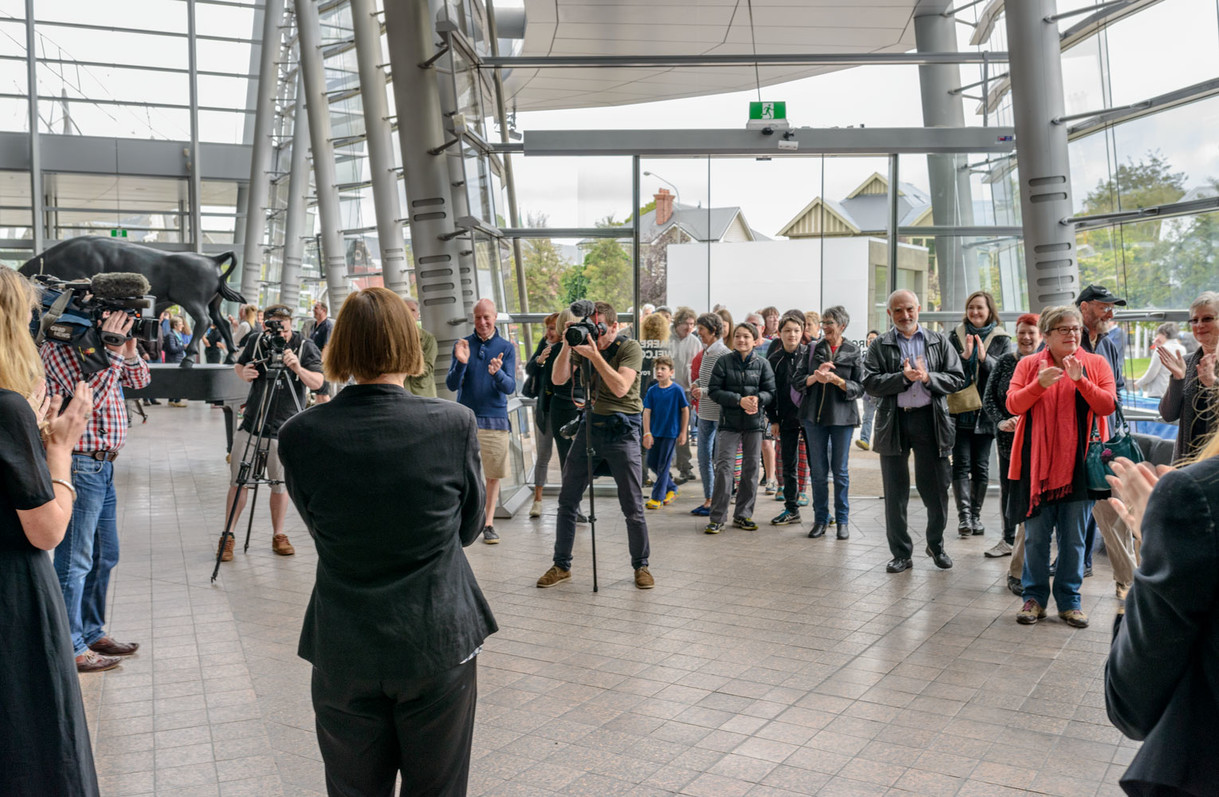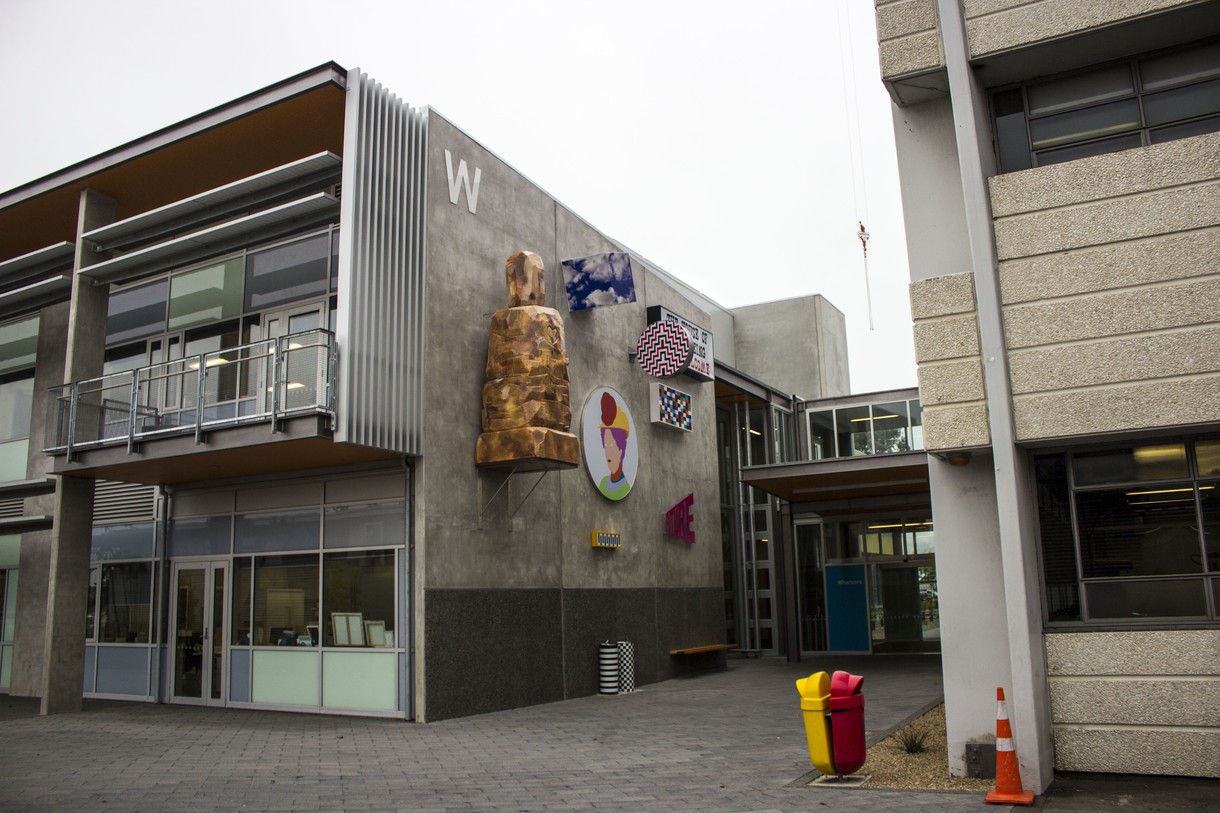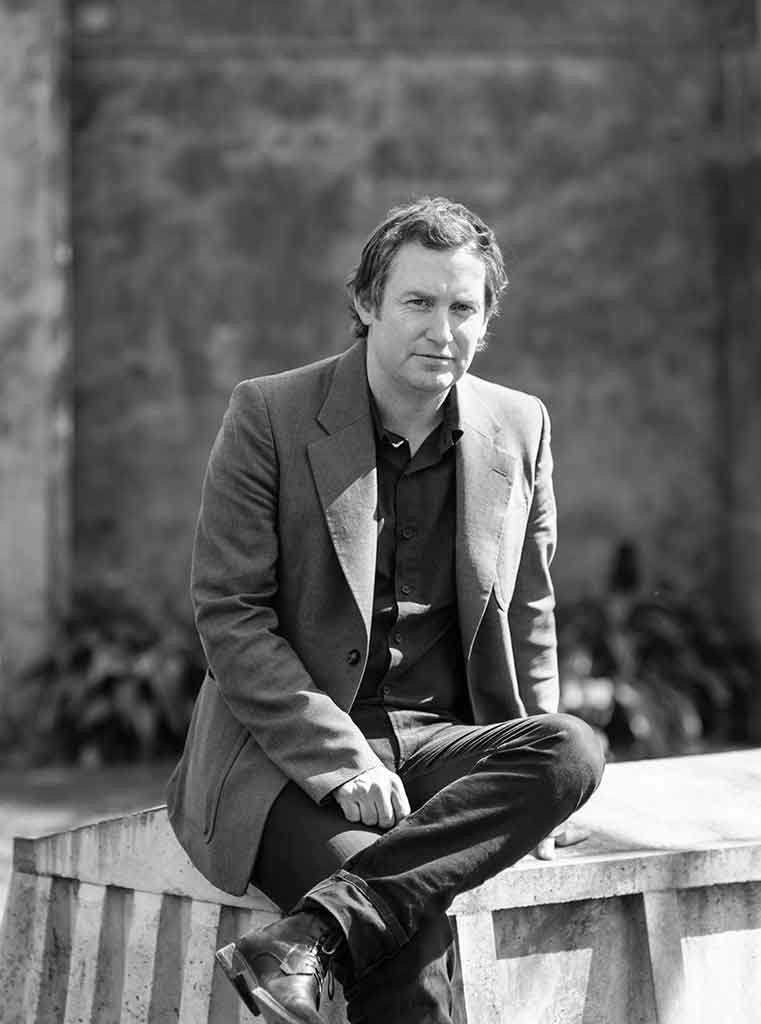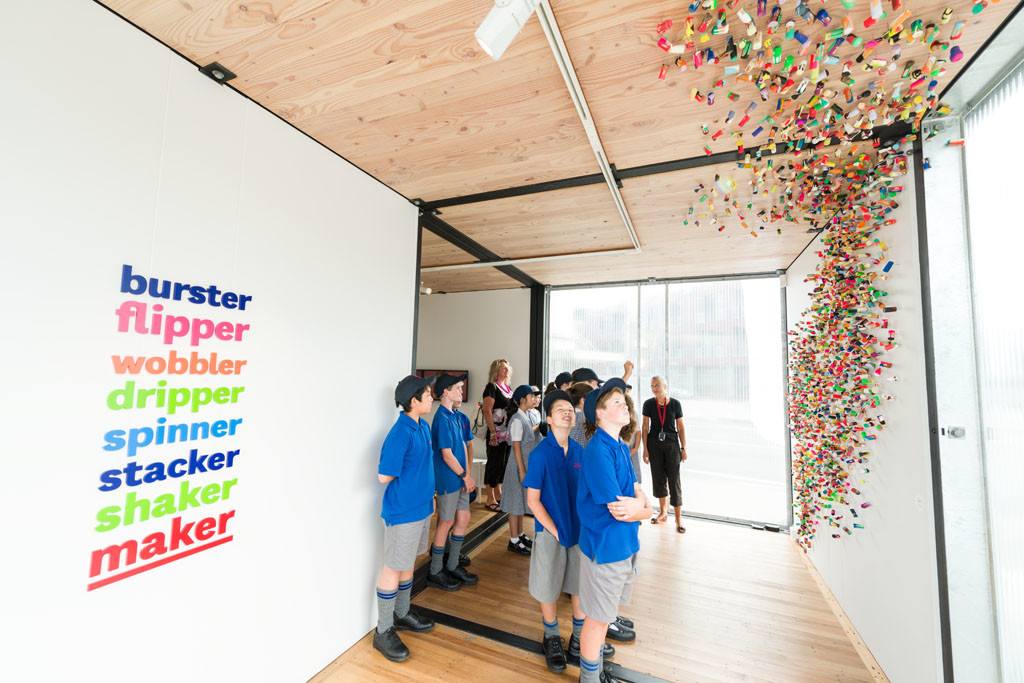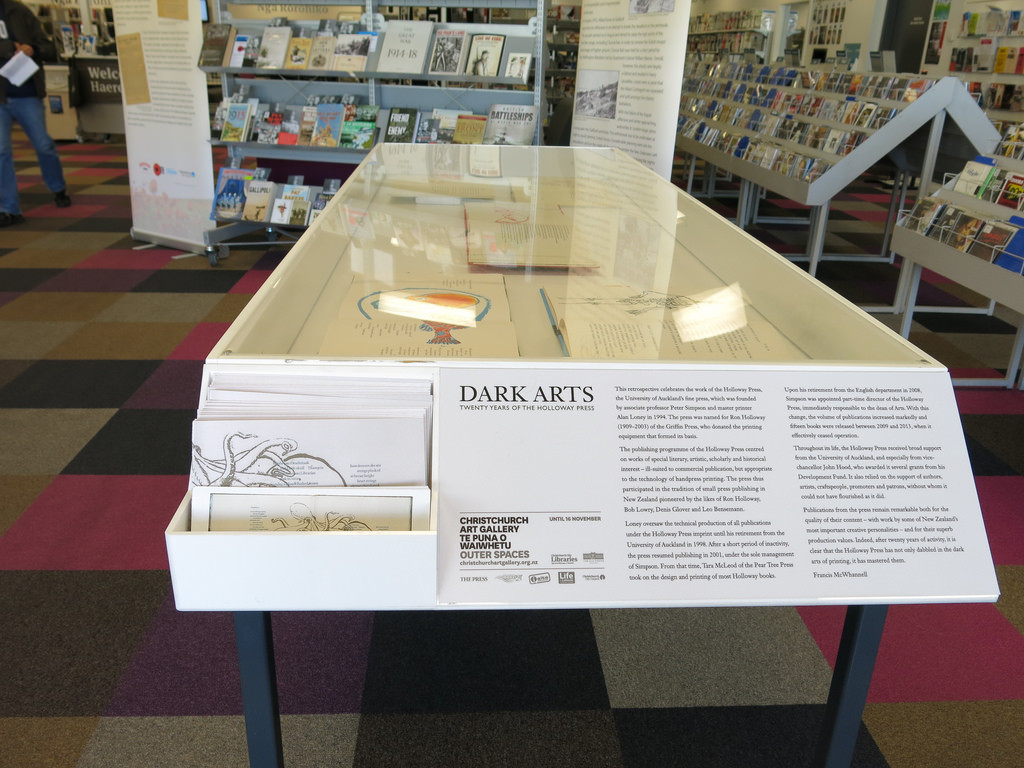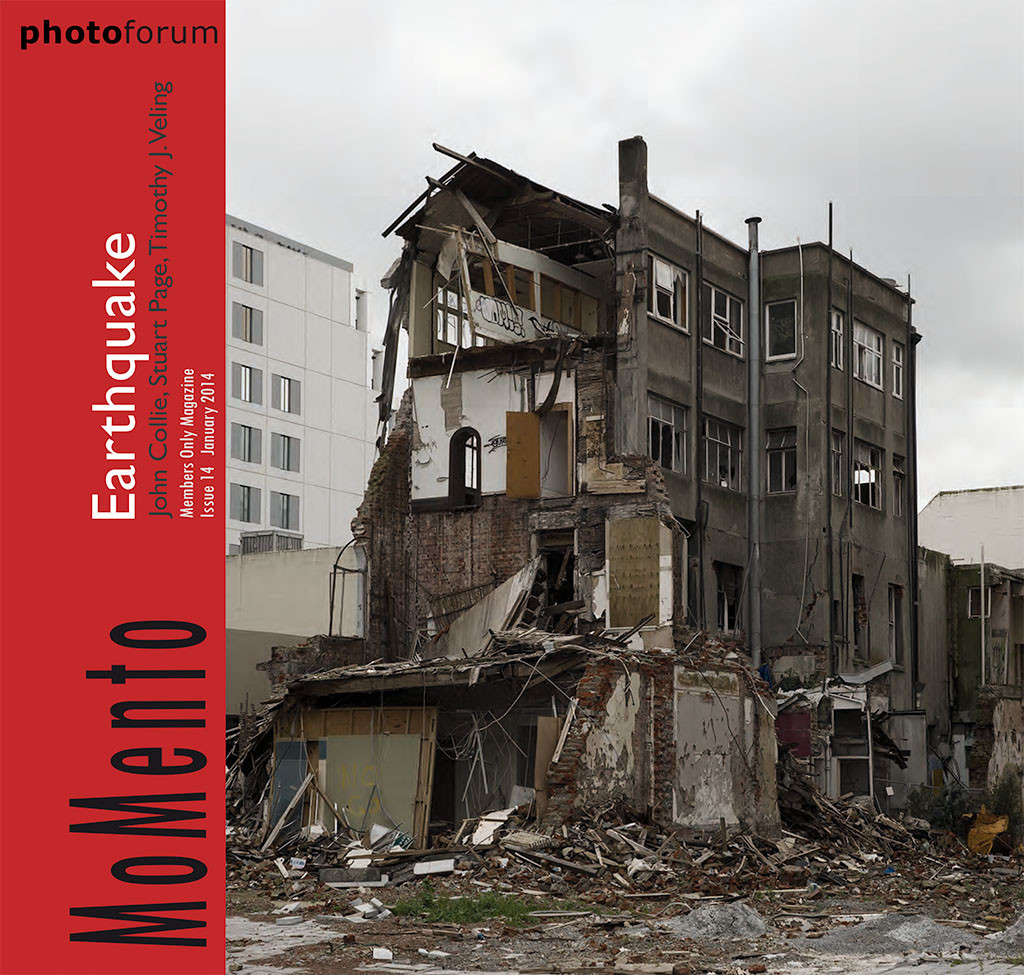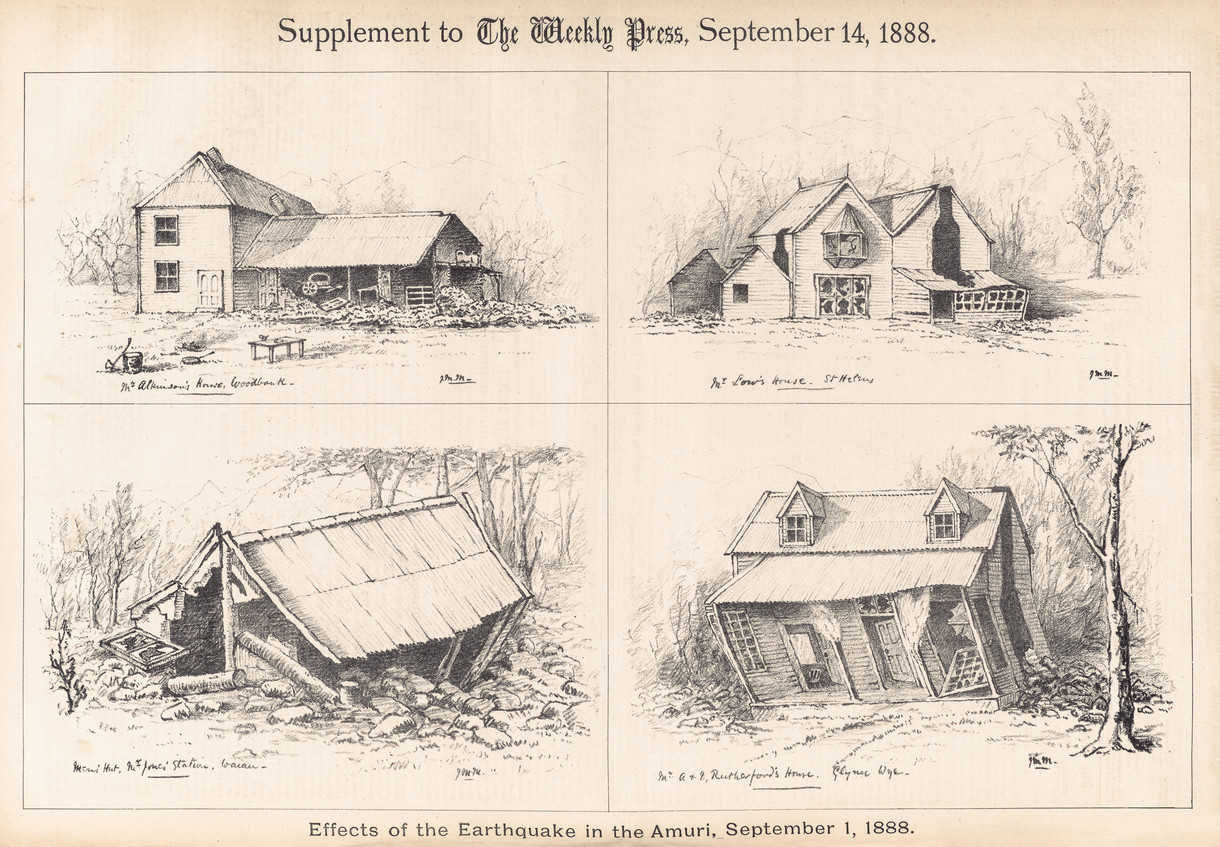Sparks that fly upwards
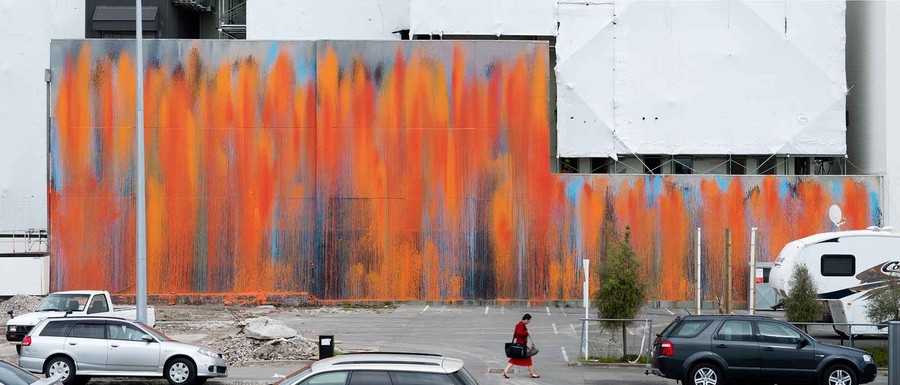
Installation view of Ash Keating Concrete Propositions 2012. Photo: John Collie
Curator Felicity Milburn remembers five years and 101 installations in a gallery without walls.
Looking back to when Christchurch Art Gallery’s Outer Spaces programme was launched in 2008, I'm struck by our easy confidence in the future—which seemed to stretch out ahead with reassuring predictability—and by the excitement we felt at the prospect of expanding art’s reach beyond our usual exhibition spaces and out onto the building's external walls, forecourt and other operational areas. It felt adventurous—ambitious even—as Fiona Pardington’s ghostly image of a glass Charlotte Jane glowed from our giant backlit billboard over Worcester Boulevard and André Hemer deployed molten, oozing colour to reactivate our water feature with Things to do with paint that won’t dry. By early 2011, the programme was in what felt like full swing, with a regular beat of projects enlivening an increasing number of sites across the Gallery footprint.
That February’s earthquake, however, which within a few, frantic hours transformed the building into an operations centre for Civil Defence, forced a rapid and radical adjustment of the Outer Spaces boundaries. With our public locked out, and no known reopening date—or at least, none that stuck—we 1 had to think past our collection and our art-friendly, environmentally-controlled building, shifting our sightlines instead to the violently changed, and still changing, expanses of the central city.
We had our doubts. How would people respond to art touching down in a city still raw from disaster? What kind of impact could we hope to have in the context of such widespread destruction? How, in city streets left unrecognisable as familiar landmarks were relentlessly demolished and trucked away, would audiences find our projects, supposing they even wanted to? And yet, as the weeks wore on, it became increasingly clear that Christchurch’s new enemy was not the still-frequent aftershocks, but the insidious, grinding bleakness of the recovery. Stoked in no small part by the enthusiasm of then-senior curator Justin Paton, our confidence grew that art could be part of the solution. Press releases from that time declare our intentions with considerably more assurance than we felt: we’d establish a gallery without walls, we declared, injecting ‘moments of surprise, humour, colour and wonder into the post-quake Christchurch streetscape’.
The first two projects unfolded on our own forecourt: Julia Morison’s Aibohphobia wrapped our unsightly carpark bunker with a dizzying pattern in on-trend hi-vis, and Matt Akehurst’s signpost sculpture You are here referenced our complicated, long-distance relationship with international culture. Then, in December 2011, the Gallery collaborated with Gap Filler to help Wayne Youle pull off I seem to have temporarily misplaced my sense of humour, his super-sized mural in Sydenham. What we didn’t know then (and we didn’t know a lot) was that the Outer Spaces programme would not only expand geographically, but also accelerate. In the almost-five-years between our closure and (imminent) reopening, the Gallery eventually realised 101 individual projects in and around the central city.
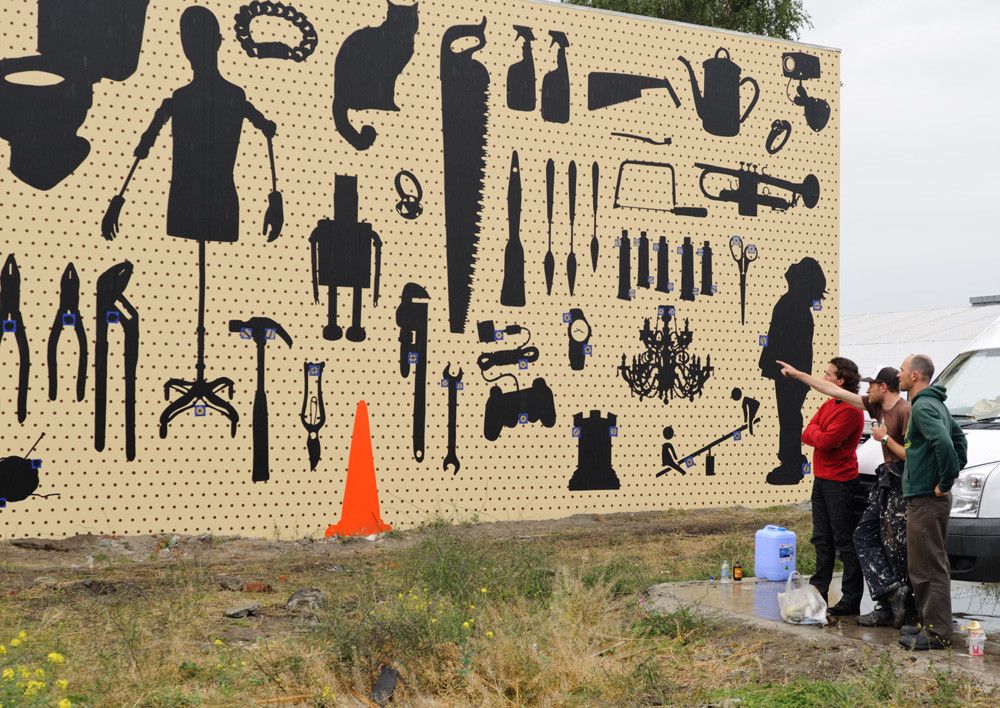
Gallery team installing Wayne Youle I seem to have temporarily misplaced my sense of humour 2011. Acrylic house paint on concrete. Photo: John Collie

Ash Keating creating Concrete Propositions 2012. Acrylic house paint on concrete. Courtesy the artist and Fehily Contemporary, Melbourne Australia. Photo: John Collie
Even now, there’s plenty that’s shocking and disorienting about central Christchurch, but in those first years it really was like venturing onto a new frontier. Several of the sites we co-opted were at the edge of the emergency cordon, and during installation we’d encounter far more civil defence workers, engineers and army personnel than casual passers-by. There’s a great photograph, taken by Gallery photographer John Collie, of Australian artist Ash Keating. He’s in the midst of creating his huge, colourful wall painting Concrete Propositions, a Gap Filler/Christchurch Art Gallery collaboration that involved Keating firing paint from numerous devices, including the fire extinguishers he’s carrying. He’s making an artwork, of course, not bringing down a government, and his once-pristine tracksuit was acquired specially for the performance, yet something about his post-apocalyptic attire and sense of grim purpose sums up for me the wild-west/urban-revolution ambience of those times. As envoys from a public institution, we were working well outside our comfort zone, but there was also an intoxicating whiff of freedom in the air, as though the earthquakes had somehow recalibrated and democratised Christchurch’s unwritten rules of access, replacing its customary default resistance to public art with a new (and, we assumed, temporary) tolerance. For a while at least, the challenges we faced when siting works in the cityscape were primarily logistical, rather than political.
Unpredictable, and often excruciatingly inconvenient, weather may not have been scientifically verified as a post-quake phenomenon, but we certainly had our share of it, from the sleet and snow that accompanied the set-up of Sian Torrington’s How you have held things, an intricate installation constructed from salvaged materials on an empty section in Avonside’s Red Zone, to the typhoon-like weather-bomb that dropped in just as Ronnie van Hout’s Comin’ Down went up on the roof garden of the old post office in High Street. The Gallery team meticulously painting Wayne Youle’s mural—not only the 95 objects, but each of the more than 10,000 dots—baked in the hot sun for most of the installation period, then found themselves running for cover as rain poured down on the last available day. Just as they were huddling together, working out how to explain to the curator (Justin Paton) that they’d warned him it was a weather-dependent project, the sky cleared. Scrambling, they finished on time, wiping up the by-now dripping paint as they went along.

Installation view of Sian Torrington’s How you have held things 2013. Salvaged materials. Photo: John Collie
As time went by, the post-quake art scene grew considerably, with an increasingly diverse range of players, from institutions and collectives to independent artists, ensuring that a wide spectrum of practice emerged throughout the city. Accustomed to the relative hermetic sanctity of our institutional white cube, it required an undeniable adjustment of perspective to see our carefully orchestrated projects bump up against art works (graffiti included) with a completely different aesthetic. There was no telling what our works might end up sitting next to; once up they were released into an evolving context as the city changed around them. Judging by the response of one tagger—who objected to us pasting up a large-scale reproduction of Tony Fomison’s No! over a pre-existing tag, the sense of frisson was mutual. ‘Keep your shit 4 the Gallery,’ it hissed. Fair enough, we felt like replying, we would if we could. If it wasn’t a new artwork going up around the corner, it was a wall coming down—sometimes one we had pegged for a project: the chaotic and rapidly changing nature of the urban environment could not have been further removed from the serene constancy of the Gallery. We honed our flexibility and Zen-like acceptance by the day, but, as usual, the artists we worked with were always far cooler about this sort of thing than we were.
Working from site to site on one-off projects proved as exhausting as it was invigorating, so three temporary spaces gave us a welcome place to hang our hats and—crucially—restore some kind of continuity for our visitors. In 2012, we leased an upstairs room in the NG building at 212 Madras Street, a Victorian warehouse lovingly restored and strengthened by Roland Logan and Sharon Ng. The conversion of this space into a gallery involved not only clearing it of several years’ worth of accumulated furniture and other objects, but wire-brushing sections of the ceiling that had been charred from a previous fire, installing lighting tracks and, later, a degree of environmental control. Steel reinforcing beams gave the space an appealingly rugged character and the view out of the end windows, across the most ravaged parts of the city, was jaw-dropping from every angle. It’s hard to imagine a better location for our first show there, Julia Morison’s Meet me on the other side, a tense and disconcerting meditation on the transformation and loss that characterised the earthquakes.
Fulfilling a promise the artist made to the city following the quakes, Michael Parekowhai’s Venice Biennale exhibition On First Looking into Chapman’s Homer was reconfigured for the NG space—with the intricately carved red piano, He Kōrero Pūrākau mo te Awanui o Te Motu: Story of a New Zealand River, installed upstairs, overlooking two bronze bulls on pianos on the rough ground outside. One of the Gallery’s visitor hosts, Michael Purdie, remembers standing at the window, looking out over the devastated cityscape in the winter twilight, while a pianist played ‘something quite beautiful, Chopin I think’. Parekowhai’s bulls prompted many connections during that exhibition—children swarmed over them, helmeted motorcyclists patted glossy black rumps with grudging admiration, and they caused near-misses as drivers gave them a too-long second glance—but it was the sound of that piano, combined with the end-of-the-world-as–you-knew-it view, that brought several of our visitors to tears.
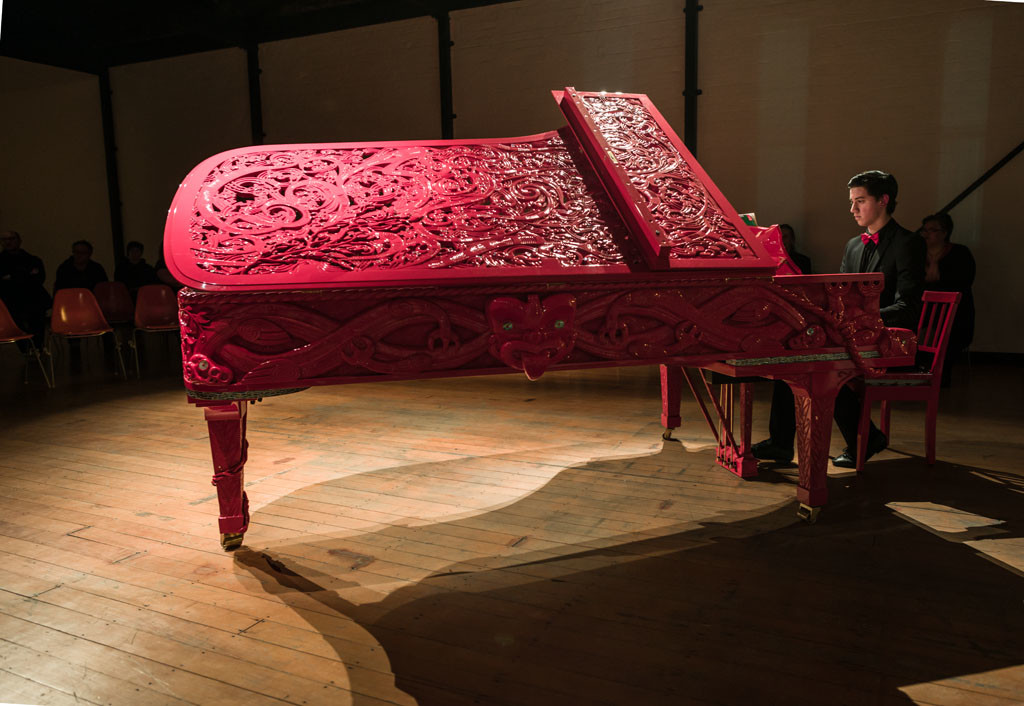
Installation view of Michael Parekowhai’s He Korero Parakau mo Te Awanui o Te Motu: story of a New Zealand river 2011. Wood, ivory, brass, lacquer, steel, ebony, paua shell, resin, mother of pearl. Collection of Te Papa. Photo: John Collie
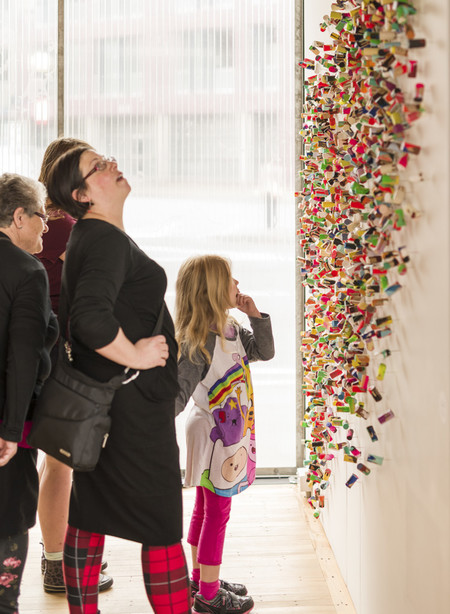
Installation view of Burster Flipper WobblerDripper Spinner Stacker Shaker Maker 2014. Photo: John Collie
ArtBox, constructed from a cluster of modular steel cubes, was set up by CPIT on an empty section in the CBD as part of a short-term creative precinct and we were invited to programme its first year of exhibitions. The compact layout, intersecting views and natural light presented some challenges, but it proved an ideal venue for Bodytok Quintet, an interactive video installation by New Zealand sound artist Phil Dadson. After that, it hosted the ebullient Burster Flipper Wobbler Dripper Spinner Stacker Shaker Maker, an exhibition of contemporary work by New Zealand and Australian artists that placed the emphasis on the act of making, and was intended to appeal to children and families. A temporary onsite classroom allowed our educators to accommodate regular school groups and holiday classes. When we planned the show, in response to extremely limited opportunities for young art viewers in post-quake Christchurch, we weren’t certain that parents would want to bring their children so far into the city, still resounding with the impacts of constant demolition. When we opened with a family fun day, however, around 2,500 people attended, and a steady flow of visitors continued throughout the exhibition’s run.
Our third temporary gallery (only recently vacated) was situated above C1 café in the old post office building on the High/Tuam corner and had the most conventional fit-out. First hosting Huggong, Seung Yul Oh’s enormous, space-hogging balloons, it was later divided into two rooms, which facilitated a range of exhibitions, from a meditative Tai Chi ‘time-slice’ by Daniel Crooks 2 to the elegant, thoughtful group show Shifting Lines.
We continued to refresh our existing sites on the Gallery’s exterior and forecourt with new works, and added a few new locations nearby. Tim J. Veling’s photograph of a brick wall 3 took up temporary residence across one of our closed-off entrances, and the old villa opposite the Gallery on Worcester Boulevard housed a series of increasingly off-beat projections by the likes of Ronnie van Hout, Justene Williams and Steve Carr. 4 Tjalling de Vries’ monumental paste-up of paper sheets on the rear wall of the CoCA building, revealed new layers of imagery as the wind and rain gradually peeled it away. 5 The new Central Library Peterborough provided both the setting for a work by Richard Killeen and also a venue for a series of book-related exhibitions. 6
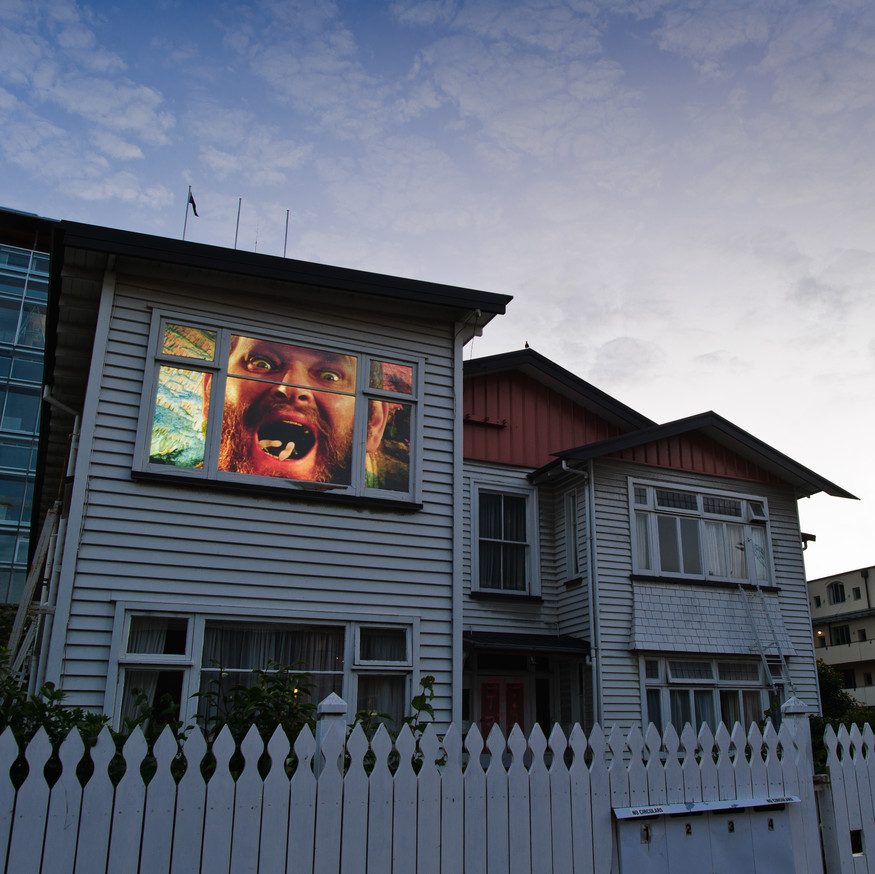
Installation view of Ronnie van Hout The creation of the world 2011. Digital video. Collection of the artist. Photo: John Collie
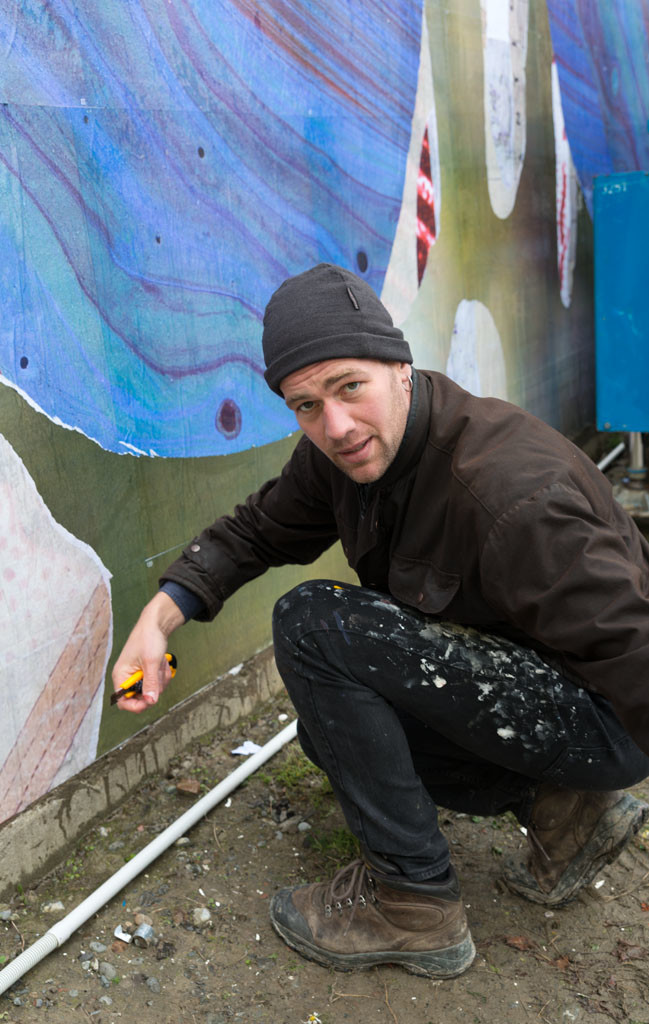
Installation view of Tjalling de Vries Tjalling is innocent 2012. Paper collage. A Christchurch Art Gallery Outer Spaces project in association with CoCA. Photo: John Collie
Above all else, the post-quake environment fostered adaptation, and many of our projects were realised in ways that we might not have previously considered. They included a poster run featuring Elliot Collins’ delicately optimistic word paintings 7 and special artist publications in the form of Christchurch Hills, a hand-stitched book of watercolour drawings by Brenda Nightingale and Unreal Estate, Tony de Lautour’s mordant commentary on the post-quake property market. Realised as a series of printed billboards that stretched down Worcester Boulevard, Reconstruction: Conversations on a City traced the history of Christchurch Ōtautahi through its built heritage and the walk-through format proved surprisingly satisfying and rewarding.
The motivation for most of our projects was simple; where we saw an opportunity to make good art happen, we tried to grab it. Rolling Maul had an additional purpose, addressing the desperate lack of exhibition venues for local artists. Conceived as a single, multi-artist exhibition to which new works were added each week, it was originally slated for the Gallery’s eagerly anticipated reopening in July 2011. When that date was indefinitely deferred, Rolling Maul was put on hold until we established our temporary space in the NG building—it eventually ran out as a nine-part exhibition series, featuring solo and small group exhibitions by 18 artists with Christchurch connections.
In all of this activity, a lingering regret remained—the continued absence of the city’s collection, locked in secure storage back at the Gallery. In fact, the collection was not static at all; it had to be shifted several times to accommodate repair work within and beyond the building, but although we lent as many works as we could to institutions throughout the country, for insurance reasons, we were largely unable to display collection works elsewhere in Christchurch. To counteract this, we exhibited Faces from the collection, a series of reproductions on walls around the city. Not quite the real thing, they nevertheless allowed the public to reengage with the collection and the combination of historical portraits with contemporary urban life provided for intriguing and often rewarding juxtapositions.
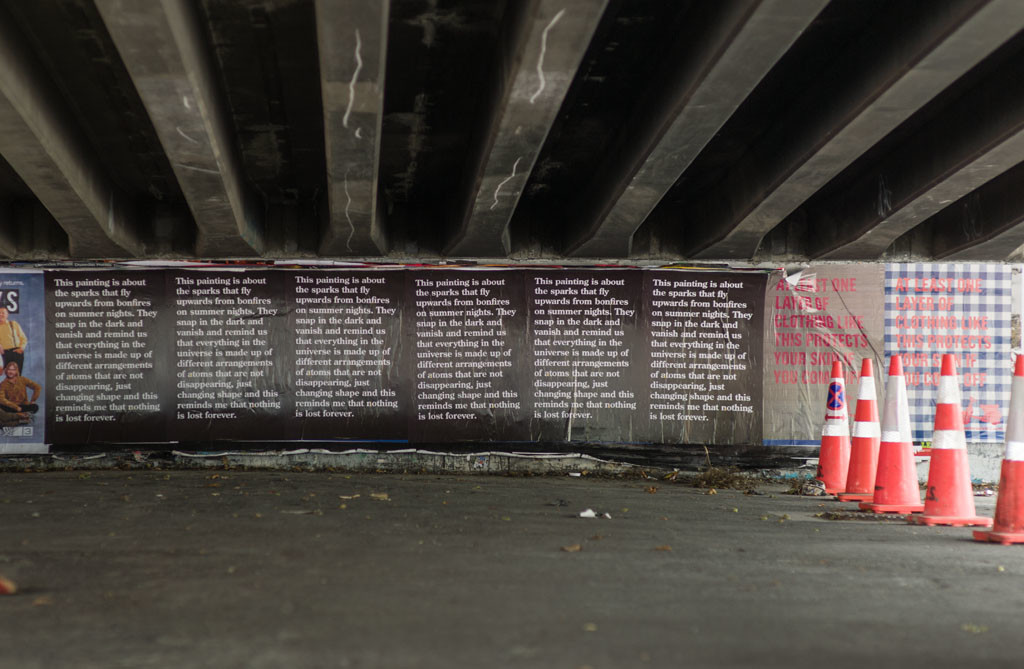
Installation view of Elliot Collins For those who stay behind 2012. Ink on paper. A Christchurch Art Gallery Outer Spaces project. Photo: John Collie
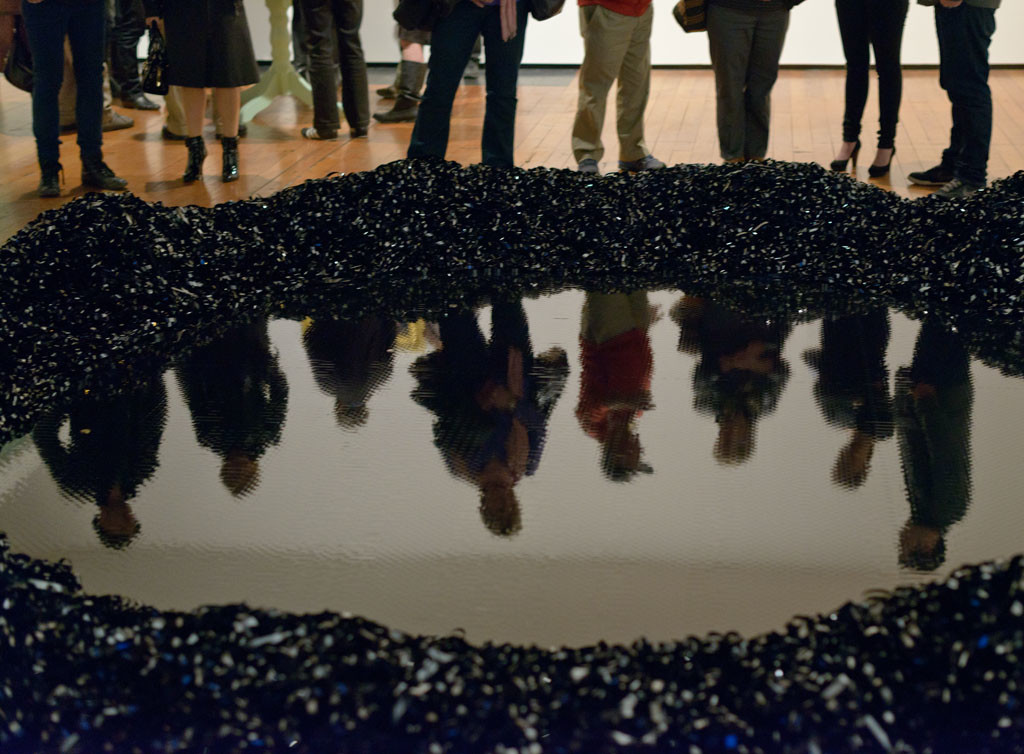
Installation view of Scott Flanagan’s Do You Remember Me Like I Do 2012, part of the Rolling Maul series of exhibitions. Photo: John Collie
These days, as Christchurch Art Gallery's reopening draws closer with every Fulton Hogan shift, our focus is squarely back on getting it alive and humming with great art. Rediscovering our exhibition spaces, we’re imagining them filled again with people, who'll be renewing their connections with our collection, marooned in storage for almost five years. Beyond our newfound (and heart-felt) appreciation for luxuries like a well-stocked tool cupboard, environmental controls and a stable address, it’s yet to be seen how the experiences of our earthquake years will affect the way the Gallery operates in the years to come, and how far we’ll stretch our programmes beyond the boundaries of our site. Like most institutions, we’d talked often in the past about the power and importance of art, but seeing it in action, during moments when even brief interactions could have a lasting impact, inevitably strengthens our sense of purpose. Outside our walls, projects felt more peripheral than when they took centre stage in the gallery environment, but they were also somehow more alive in the rough and tumble of the real world. It seems to me to be entirely appropriate that the work that signs off our gallery without walls years is Martin Creed's 45 metre technicolour beacon Work No. 2314, reading ‘everything is going to be alright’. If the last half-decade is anything to go by, we might best regard it as less of a comforting platitude and more of a call to arms.
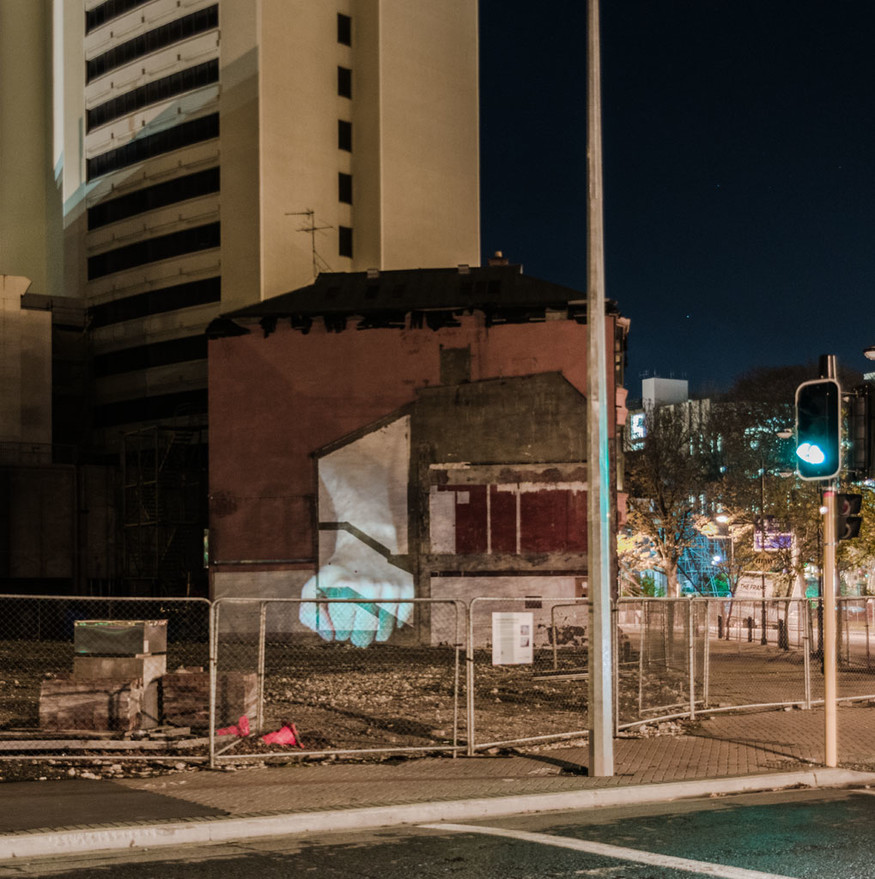
Installation view of Tony Oursler’s video work Fist, part of Bright Burn Want, 2013. Photo: John Collie








